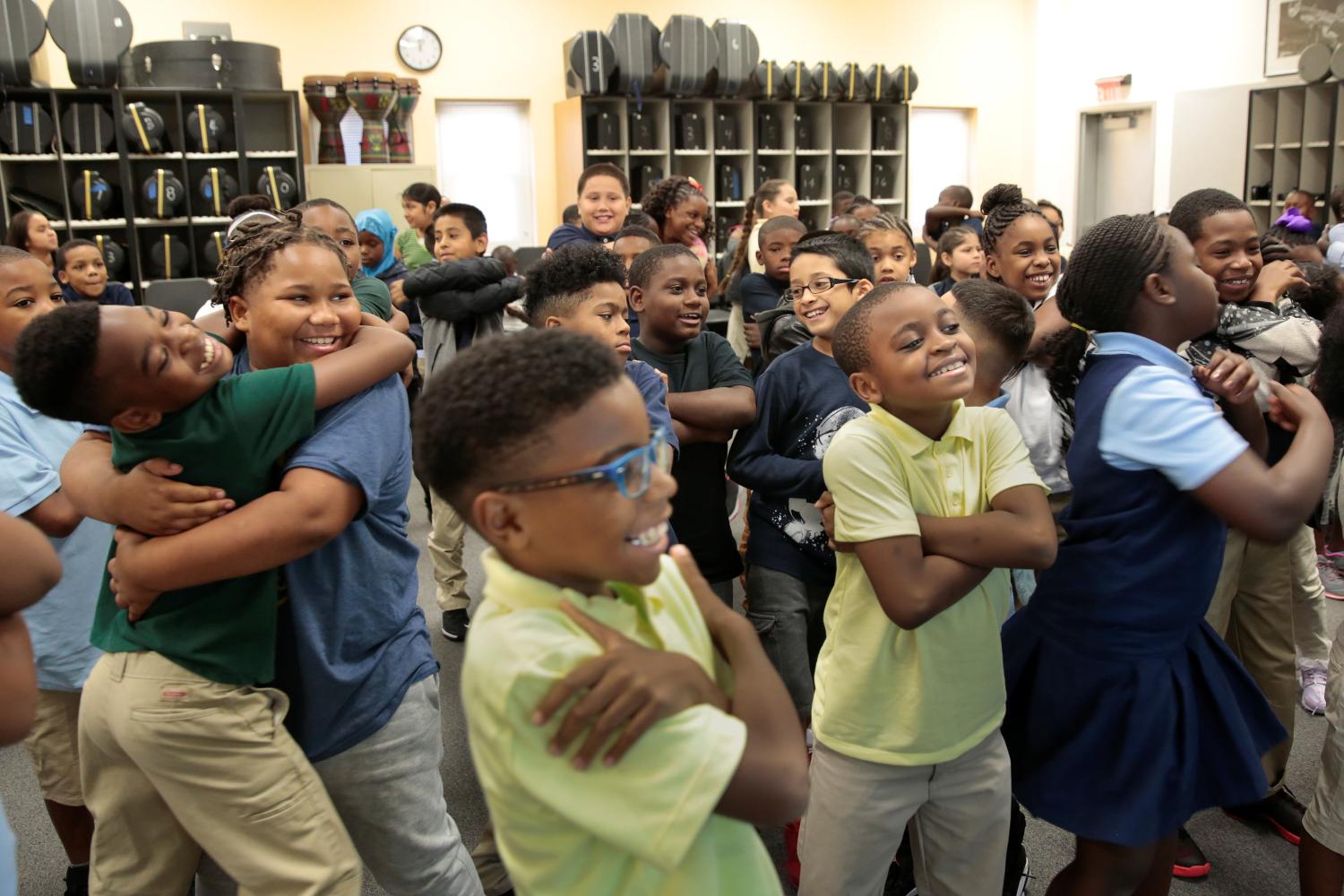Executive Summary
Responding to the need to look beyond test scores to measure school quality, an increasing number of school districts are striving to incorporate socio-emotional learning measures in their accountability policies. Growth mindset – believing that intelligence and talent can change – is one of these measures. Experimental research has found that developing a growth mindset can improve academic achievement and that schools can affect students’ mindset. However, until now we have not known how mindset varies across and within American schools or whether measures of mindset on a large-scale predict students’ future learning. A new study fills this gap by using data from five school districts in California that measure growth mindset for students in 3rd to 8th grade to assess the extent that students with stronger growth mindset learn more in a given year than those without. It finds that traditionally underserved students – including students in poverty, English learners, Hispanics, and African-American students – are less likely to hold a growth mindset. Yet, for all groups, students with a growth mindset learn more over the course of year than otherwise similar students who do not have a growth mindset. While this study is just a first step in assessing the effects of mindset on a large population of students and the role of schools in building mindset, the findings provide initial evidence that it may be beneficial to monitor the levels of growth mindset in the population and convey to students that the brain is malleable.
Teaching students that their intelligence can increase1 can help them maintain motivation in face of challenges2 and promote academic achievement.3 This belief that one’s capabilities can change is known as having a growth mindset. Experiments in schools have found that sessions designed to promote a growth mindset4 benefit academic achievement of students, especially those with initially low grades or in higher risk of failing.5 This evidence has motivated foundations, non-profit organizations, and governmental agencies to invest in growth-mindset dissemination.6 In addition, school districts have begun to use surveys to assess students’ growth mindset, including the CORE consortium of districts in California.7
This focus on growth mindset and investment in programs to build growth mindset has increased even though we have known very little about what mindsets students’ hold, how they vary across the population of students and whether they predict academic learning at a large-scale. Our current understanding of the impact of growth mindset has emerged from causal studies using convenient samples of college and secondary-school students or from experiments and cross-sectional data outside of the US,8 and we do not yet know whether those studies’ conclusions extend to the large and diverse populations in US schools. Knowing whether or not growth-mindset studies are generalizable across a wide variety of populations can help us better understand the need for and scope of potential policies for cultivating growth mindset.
In a new study presented at the this year’s fall research conference of the Association for Public Policy Analysis and Management in Chicago, we used data from CORE Districts, to assess whether there are systematic mindset differences present in the US population within and across schools, and whether holding a growth mindset predicts academic achievement gains of students. The CORE Districts are a collaboration of large urban school districts in California that began measuring social-emotional skills, including Growth Mindset, as part of an innovative multiple-measures data system under a No Child Left Behind flexibility request. Our analyses were based on the approximately 125,000 students in grades four through seven within these districts who completed the surveys in spring 2015 and whose responses we can link to data on test scores in grades three through eight from spring 2013 to spring 2016.9 We measure growth mindset based on students’ answers to the following four questions:
Please indicate how true each of the following statements is for you:
- My intelligence is something that I can’t change very much;
- Challenging myself won’t make me any smarter;
- There are some things I am not capable of learning; and
- If I am not naturally smart in a subject, I will never do well in it. For each of these questions, students choose: Not at All True, A Little True, Somewhat True, Mostly True, or Completely True
figure 1: mindset gaps per subgroups and grades10

As shown in Figure 1, we find that students with socioeconomic disadvantages tend to have less of a growth mindset. Students who are eligible for free or reduced priced lunch, English Language Learners, African American, and Hispanic students report lower growth mindsets than their peers. Female students hold higher growth mindset than male students up to 7th grade, where the mindset gap between males and females closes. These patterns appear within schools as well as across the population, however, gaps within schools are much smaller than across schools. The smaller differences across student groups within schools than between schools could arise if students sort systematically into schools with similar students, or it could be due to the effects that schools might have on students’ social emotional development.
When comparing students, we also find that students with higher test scores in math and English language arts have stronger growth mindset. While the relationship is strong, it is not necessarily due to growth mindset causing greater learning. In fact, it could just as logically be due to students’ beliefs about the potential for their capabilities to increase improving as a result of learning more. To better isolate the causal effects of growth mindset on learning, we use regression analysis controlling for a rich array of student characteristics and two years of previous achievement, as well as indicators for each school. That is, we compare students with the same demographic characteristics, the same test scores in the current year and in a previous year, the same responses to the surveys for other social-emotional measures collected by the district, and within the same school and grade, to see whether students who look the same on all of these measures but have a stronger growth mindset learn more over the course of the following year. We find that they do.
Even the most conservative models provide evidence that growth mindset predicts achievement a year later. The relationship is not as strong as the simple correlation between growth mindset and achievement levels, but it is meaningful in size. A student with a growth mindset in spring 2015 has ELA and Math test scores in the spring of 2016 that are approximately 0.07 and 0.04 standard deviations (SD) higher than a similar classmate (i.e., a classmate with the same previous achievement and demographic characteristics in the same school) with a fixed mindset (approximately two standard deviations below).
Moreover, we see greater learning for students with a stronger growth mindset across all groups of students – by race and ethnicity, poverty, gender, prior score. As seen in Figure 2, for each subgroup that we look at we find that mindset predicts achievement gains. Students with a growth mindset present a higher increase in achievement at higher grades, a difference that may be due to actual differences or to differences in the accuracy of reporting for older students relative to younger students.

How large are the effects of mindset on academic achievement? We estimate that the average growth in English language arts scores due to changing from a fixed mindset to a neutral mindset (a one standard deviation change) is between 0.03 and 0.02 standard deviations in test performance. Based on a rough calculation developed by Hanushek and his colleagues,11 this is equivalent to approximately 19 days of learning – almost a calendar month of school. This magnitude is meaningful considering that we are analyzing a social-emotional barrier that could potentially be addressed by low cost interventions. In fact, this effect appears to be comparable to the average annual growth that the California education system achieved between 1992 and 2011, which has been estimated as 0.02 standard deviations.12 The effect of mindset estimated in this study seems promising, especially considering that about 75 percent of students in each grade have room to improve their mindset score by one standard deviation or more.
The increasing interest on developing a growth mindset in students has grown without information on how growth mindset is distributed across the population and whether it matters at a large scale. The new study offers the first evidence of growth mindset distribution and its relationship with achievement and student demographics that is available in the US at a large scale. The analysis identifies a mindset gap across subgroups, even within schools, and it confirms that mindset predicts achievement gains for students, even with unusually rich controls for students’ background and schooling.
Before pursuing a growth mindset campaign across schools, more is needed to understand the validity of the growth mindset measures and how to build growth mindset effectively at scale. Some students, for example, may have less access to growth mindset messages and thus could benefit from increased exposure to this messaging at school. However, lower levels of mindset may also stem from structural barriers to success and perceptions of inequality in access to opportunities.13 Such sources of differences across students in mindset are unlikely to be overcome solely by low-cost interventions in schools. Additionally, researchers have only begun to develop valid and reliable measures of growth mindset. The measure of growth mindset used by the CORE districts, for example, which is not the same as the instrument created by Dweck and colleagues and used in previous studies,14 may be more predictive than the initial measure, but still suffers from measurement issues, particularly for younger students.15
While this study is just a first step in assessing the effects of mindset on a large population of students and the role of schools in building mindset, the findings provide initial evidence that it may be beneficial to monitor the levels of growth mindset in the population and convey to students that the brain is malleable.
The authors did not receive any financial support from any firm or person for this article or from any firm or person with a financial or political interest in this article. They are currently not an officer, director, or board member of any organization with an interest in this article.
-
Footnotes
- Dweck, C. S. (1999). Self-theories: Their role in motivation, personality and development. Philadelphia: Psychology Press.
- Dweck, C. S., & Leggett, E. L. (1988). A social-cognitive approach to motivation and personality. Psychological Review, 95(2), 256–273; Mueller CM & Dweck CS (1998) Praise for intelligence can undermine children’s motivation and performance. J Pers Soc Psychol 75(1):33–52.
- Good C, Aronson J, Inzlicht M (2003) Improving adolescents’ standardized test performance: An intervention to reduce the effects of stereotype threat. J Appl Dev Psychol 24(6):645–662; Aronson, J., Fried, C. B., & Good, C. (2002). Reducing the Effects of Stereotype Threat on African American College Students by Shaping Theories of Intelligence. Journal of Experimental Social Psychology, 38(2), 113–125; Blackwell, L. S., Trzesniewski, K. H., & Dweck, C. S. (2007). Implicit theories of intelligence predict achievement across an adolescent transition: A longitudinal study and an intervention. Child Development, 78(1), 246–263. Paunesku D, et al. (2015) Mind-set interventions are a scalable treatment for academic underachievement. Psychol Sci 26(6):784–793; Yeager DS, et al. (2016) Using design thinking to make psychological interventions ready for scaling: The case of the growth mindset during the transition to high school. J Educ Psychol 108(3):374–391.
- For examples of these sessions go to www.perts.net
- Paunesku et al. (2015); Yeager et al. (2016).
- Obama, Barack (2014) Weekly Address: Everyone Should Be Able to Afford Higher Education http://www.whitehouse.gov/photos-and-video/video/2014/08/15/weekly-address-everyone-should-be-able-afford-higher-education Last retrieved October 2015; National Science and Technology Council (2015) Social and Behavioral Sciences Team. Annual Report https://sbst.gov/assets/files/2015-annual-report.pdf Last retrieved October 2015.
- The CORE is a consortium of nine California school districts that implemented a pilot to create a comprehensive accountability system by assessing school performance through a variety of measures that go beyond academic achievement tests. Five of these districts, operating under a U.S. Department of Education waiver, began collecting measures of growth mindset, among other socio-emotional skills, for all of the students between 3rd and 11th grade, through surveys.
- Good, Aronson, & Inzlicht, 2003; Aronson et al., 2002; Blackwell et al., 2007; Paunesku et al., 2015; Yeager et al., 2016; Claro, S., Paunesku, D., & Dweck, C. S. (2016). Growth mindset tempers the effects of poverty on academic achievement. Proc. Natl. Acad. Sci. U.S.A. 113, 8664–8668. One of the latest biggest experiments was carried out in Perú randomizing across schools: Outes, I., Sánchez, A., and Vakis, R. (2017) Cambiando la mentalidad de los estudiantes: evaluación de impacto de ¡Expan- de tu Mente! sobre el rendimiento académico en tres regiones del Perú. Documentos de investigación, 83. Lima: GRADE.
- California did not assessed students during the 2013-14 academic year, hence we only controlled by students’ achievement collected in Spring 2013 and Spring 2015
- Figure 1 mindset gaps across the population in CORE districts, in standard deviations. Mindset is standardized within grade to have a mean of 0 and standard deviation of 1 in each grade.
- Hanushek, EA., Peterson, PE & Woessmann, L (2012). Is the US Catching Up? International and State Trends in Student Achievement. Education Next 12(4).
- idem
- Kraus M.W., Piff P.K., Keltner D. (2009). Social class, sense of control, and social explanation. Journal of Personality and Social Psychology, 97, 992–1004.
- Previous studies use the traditional mindset instrument developed by Dweck (1999). See, for examples, Claro et al. (2016) and Paunesku et al. (2015).
- For more information on the CORE Districts and measures see http://coredistricts.org/our-work/.
The Brookings Institution is committed to quality, independence, and impact.
We are supported by a diverse array of funders. In line with our values and policies, each Brookings publication represents the sole views of its author(s).









